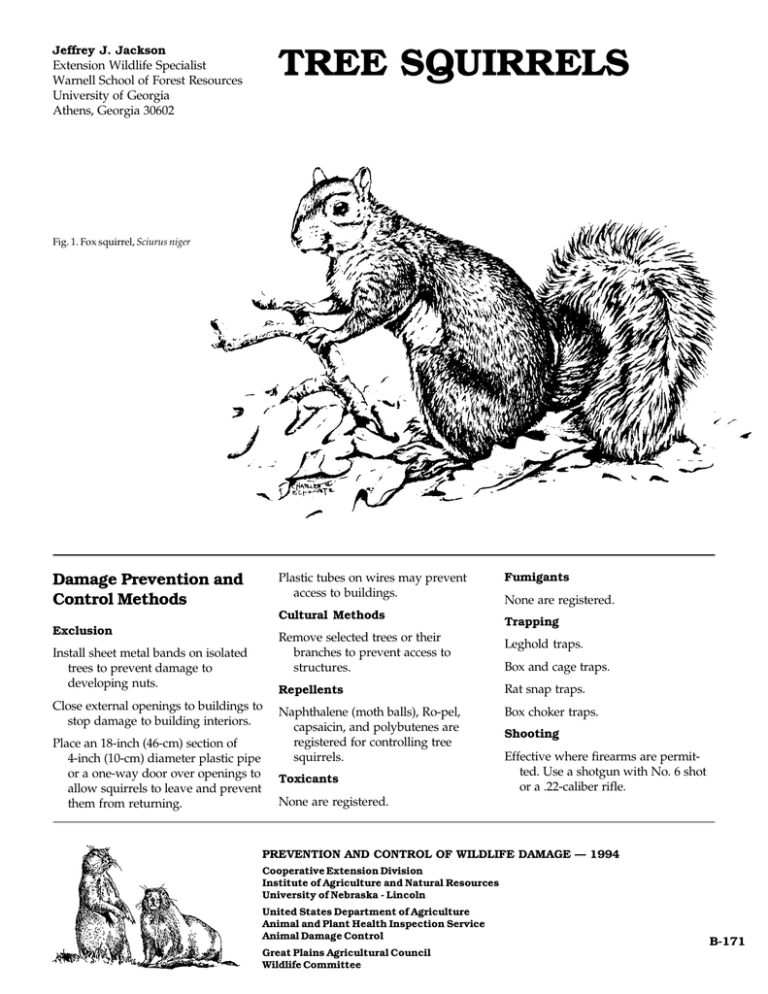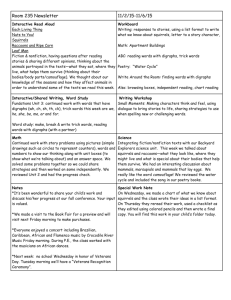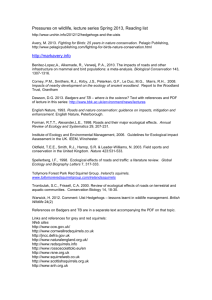TREE SQUIRRELS
advertisement

Jeffrey J. Jackson TREE SQUIRRELS Extension Wildlife Specialist Warnell School of Forest Resources University of Georgia Athens, Georgia 30602 Fig. 1. Fox squirrel, Sciurus niger Plastic tubes on wires may prevent access to buildings. Damage Prevention and Control Methods Cultural Methods Exclusion Remove selected trees or their branches to prevent access to structures. Install sheet metal bands on isolated trees to prevent damage to developing nuts. Close external openings to buildings to stop damage to building interiors. Place an 18-inch (46-cm) section of 4-inch (10-cm) diameter plastic pipe or a one-way door over openings to allow squirrels to leave and prevent them from returning. Fumigants None are registered. Trapping Leghold traps. Box and cage traps. Repellents Rat snap traps. Naphthalene (moth balls), Ro-pel, capsaicin, and polybutenes are registered for controlling tree squirrels. Box choker traps. Toxicants Shooting Effective where firearms are permitted. Use a shotgun with No. 6 shot or a .22-caliber rifle. None are registered. PREVENTION AND CONTROL OF WILDLIFE DAMAGE — 1994 Cooperative Extension Division Institute of Agriculture and Natural Resources University of Nebraska - Lincoln United States Department of Agriculture Animal and Plant Health Inspection Service Animal Damage Control Great Plains Agricultural Council Wildlife Committee B-171 Identification In this chapter tree squirrels are divided into three groups: large tree squirrels, pine squirrels, and flying squirrels. Large tree squirrels include fox (Sciurus niger), eastern gray (Sciurus carolinensis), western gray (Sciurus griseus), and tassel-eared (Sciurus aberti) squirrels. Fox squirrels (Fig. 1) measure 18 to 27 inches (46 to 69 cm) from nose to tip of tail. They weigh about 1 3/4 pounds (787 g) to 2 1/4 pounds (1,012 g). Color varies greatly, from all black in Florida to silver gray with a white belly in Maryland. Georgia fox squirrels usually have a black face. Ohio and Michigan fox squirrels are grizzled gray-brown above with an orange underside. Sometimes several color variations occur in a single population. Fig. 2. Range of the fox squirrel (dark) and tassel-eared squirrel (light) in North America. Fig. 3. Range of the eastern gray squirrel (dark) and western gray squirrel (light) in North America. Eastern gray squirrels are also variable in color. Some have a distinct reddish cast to their gray coat. Black ones are common in some northern parts of their range. Eastern gray squirrels measure 16 to 20 inches (41 to 51 cm). They weigh from 1 1/4 pounds (567 g) to 1 3/4 pounds (794 g). The western gray squirrel is gray above with sharply distinct white underparts. Size is similar to that of the eastern gray squirrel. Tassel-eared squirrels are similar in size to gray squirrels and have several color phases. The most common is gray above with a broad reddish band down the back. Black tufted ears are their most distinguishing characteristic (the tufts are larger in winter, about 1 inch [2.5 cm]). There are two species of pine squirrels: the red squirrel (Tamiasciurus hudsonicus) and Douglas pine squirrel (Tamiasciurus douglasii). Pine squirrels are 10 to 15 inches (25 to 38 cm) in total length and weigh 1/3 to 2/3 pounds (151 to 303 g). Red squirrels are redbrown above with white underparts. Douglas squirrels are gray-brown above with yellowish underparts. Both species have small ear tufts and often have a black stripe separating the dark upper color from the light belly. B-172 Fig. 4. Range of the red squirrel (dark) and Douglas squirrel (light) in North America. Fig. 5. Range of the northern flying squirrel (dark) and southern flying squirrel (light) in North America. Two species of flying squirrels occur in North America. The southern flying squirrel (Glaucomys volans) is 8 to 10 inches (20 to 25 cm) long. The northern flying squirrel (Glaucomys sabrinus) averages 2 inches (5 cm) longer. It can be difficult to distinguish between the two; both may be various shades of gray or brown above and lighter below. A sharp line of demarcation separates the darker upper color from the lighter belly. The most distinctive characteristics of flying squirrels are the broad webs of skin connecting the fore and hind legs at the wrists, and the distinctly flattened tail. where they have been introduced (Fig. 2). Range Red squirrels are often associated with coniferous forests. The Douglas squirrel is restricted to the west coast from southwestern British Columbia south through the Sierras to northern Baja California (Fig. 4). Fox squirrels occur in much of the eastern and central United States, as well as in several locations in the West, Eastern gray squirrels have a similar range to that of fox squirrels but do not occur in many western areas of the fox squirrel’s range. They have been introduced in several locations in the West (Fig. 3). Western gray squirrels are confined to west coast states and a small portion of western Nevada (Fig. 3). Pine squirrels occur across northern North America south into the Appalachians and Rockies, and on the west coast. The tassel-eared squirrel is restricted to Ponderosa pine forests in the Southwest, usually at altitudes above 5,000 feet (1,500 m). It occurs in portions of Wyoming, Colorado, New Mexico, Arizona, and Utah (Fig. 2). The northern flying squirrel occurs across northern North America. Its range extends south into the Appalachians and Rockies. The southern flying squirrel occurs in the central and eastern United States (Fig. 5). Habitat Fox squirrels and gray squirrels inhabit the same kinds of forests, both hardwood and coniferous, over much of their range. Gray squirrels are more abundant where a high percentage of land is forested. In areas with 10% forest cover, fox and gray squirrel populations may be equal. Fox squirrels prefer oak-hickory habitat over much of their range, especially in the West. In Georgia and Florida, fox squirrels seem to prefer pine timber. The western gray squirrel prefers mixed hardwoods and conifers and dry open hardwoods. Tassel-eared squirrels are strongly associated with Ponderosa pine. Pine squirrels prefer coniferous forests but also occur in mixed conifer and hardwood forests, or sometimes in hardwood habitats. Food Habits Fox and gray squirrels have similar food habits. They will eat a great variety of native foods and adapt quickly to unusual food sources. Typically, they feed on mast (wild tree fruits and nuts) in fall and early winter. Acorns, hickory nuts, walnuts, and osage orange fruits are favorite fall foods. Nuts are often cached for later use. In late winter and early spring they prefer tree buds. In summer they eat fruits, berries, and succulent plant materials. Fungi, corn, and cultivated fruits are taken when available. During population peaks, when food is scarce, these squirrels may chew bark from a variety of trees. They will also eat insects and other animal matter. Pine squirrels are often heavily dependent on coniferous forests for cones and buds but will also eat a variety of other foods common to gray and fox squirrel diets. Douglas squirrels depend largely on Ponderosa pine for food. Flying squirrels’ food habits are generally similar to those of other squirrels. However, they are the most carnivorous of all tree squirrels. They eat bird eggs and nestlings, insects, and other animal matter when available. Flying squirrels often occupy bird houses, especially bluebird houses. General Biology, Reproduction, and Behavior Fox and gray squirrels breed when they are 1 year old. They breed in midDecember or early January and again in June. Young squirrels may breed only once in their first year. The gestation period is 42 to 45 days. During the breeding season, noisy mating chases take place when one or more males pursue a female through the trees. They nest in tree cavities, humanmade squirrel boxes, or in leaf nests. Leaf nests are constructed with a frame of sticks filled with dry leaves and lined with leaves, strips of bark, corn husks, or other materials. Survival of young in cavities is higher than in leaf nests. Cavities are the preferred nest sites. About 3 young comprise a litter. At birth they are hairless, blind, and their ears are closed. Newborns weigh about 1/2 ounce (14 g) at birth and 3 to 4 ounces (84 to 112 g) at 5 weeks. Young begin to explore outside the nest about the time they are weaned at 10 to 12 weeks. At weaning they are about half of their adult weight. Home range size depends on the season and availability of food. It may vary from 1 to 100 acres (0.4 to 40 ha). Squirrels move within their range according to availability of food. They often seek mast-bearing forests in fall and favor tender buds in elm and maple forests in the spring. During fall, squirrels may travel 50 miles (80 km) or more in search of better habitat. Squirrel populations periodically rise and fall. During periods of high populations, squirrels—especially gray squirrels—may go on mass emigrations. At such times many animals die. Fox and gray squirrels are vulnerable to numerous parasites and diseases. Ticks, mange mites, fleas, and internal parasites are common. Squirrel hunters often notice bot fly larvae (called “wolves” or “warbles”) protruding from the skin. These fly larvae do not impair the quality of the meat for eating. Squirrels are a food source for hawks, owls, snakes, and several mammalian predators. Predation seems to have little effect on squirrel populations. Typically about half the squirrels in a population die each year. In the wild, squirrels over 4 years old are rare, while in captivity individuals may live 10 years or more. The biology of other North American squirrels has much in common with that of fox and gray squirrels, although most other species have one breeding season per year. Flying squirrels are unique in that they are active at night. All other species are active during the day. Damage Squirrels may occasionally damage forest trees by chewing bark from branches and trunks. Pine squirrels damage Ponderosa pine, jack pine, and paper birch. In the Southeast, fox squirrels damage loblolly and other pines. These species and others may eat cones and nip twigs to the extent that they interfere with natural reseeding of important forest trees. This is a particular problem in Ponderosa pine forests where pine squirrels may remove 60% to 80% of the cones in poor to fair seed years. In forest seed orchards, such squirrel damage interferes with commercial seed production. B-173 In nut orchards, squirrels can severely curtail production by eating nuts prematurely and by carrying off mature nuts. In New England fruit orchards, pine squirrels may eat ovaries of cherry blossoms and destroy ripe pears. Pine, gray, and fox squirrels may chew bark of various orchard trees. In residential areas, squirrels sometimes travel powerlines and short out transformers. They gnaw on wires, enter buildings, and build nests in attics. They frequently chew holes through pipelines used in maple syrup production. Squirrels occasionally damage lawns by burying or searching for and digging up nuts. They will chew bark and clip twigs on ornamental trees or shrubbery planted in yards. Often squirrels take food at feeders intended for birds. Sometimes they chew to enlarge openings of bird houses and then enter to eat nestling songbirds. Flying squirrels are small enough to enter most bird houses and are especially likely to eat nesting birds. In gardens, squirrels may eat planted seeds, mature fruits, or grains such as corn. Legal Status Fox and gray squirrels are usually classified as game animals in states where they occur. The tassel-eared squirrel is normally a protected species. Check with local or state authorities to determine legal status of squirrels in your area. Damage Prevention and Control Methods Exclusion Prevent squirrels from climbing isolated trees and power poles by encircling them with a 2-foot-wide (61-cm) collar of metal 6 feet (1.8 m) off the ground. Attach metal using encircling wires held together with springs to allow for tree growth. B-174 Prevent squirrels from traveling on wires by installing 2-foot (61-cm) sections of lightweight 2- to 3-inch diameter (5.1- to 7.6-cm) plastic pipe. Slit the pipe lengthwise, spread it open, and place it over the wire. The pipe will rotate on the wire and cause traveling squirrels to tumble. Close openings to attics and other parts of buildings but make sure not to lock squirrels inside. They may cause a great deal of damage in their efforts to chew out. Place traps inside as a precaution after openings are closed. A squirrel excluder can be improvised by mounting an 18-inch (46-cm) section of 4-inch (10-cm) plastic pipe over an opening. The pipe should point down at a 45o angle. A one-way door can also be used over an opening to let squirrels out and prevent them from returning. Close openings to buildings with heavy 1/2-inch (1.3-cm) wire mesh or make other suitable repairs. Custom-designed wire mesh fences topped with electrified wires may effectively keep out squirrels out of gardens or small orchards. Habitat Modification Trim limbs and trees to 6 to 8 feet (1.8 to 2.4 m) away from buildings to prevent squirrels from jumping onto roofs. In backyards where squirrels are causing problems at bird feeders, consider providing an alternative food source. Wire or nail an ear of corn to a tree or wooden fence post away from where the squirrels are causing problems. In high-value crop situations, it may pay to remove woods or other trees near orchards to block the “squirrel highway.” Repellents Naphthalene (moth balls) may temporarily discourage squirrels from entering attics and other enclosed spaces. Use of naphthalene in attics of occupied buildings is not recommended, however, because it can cause severe distress to people. Supplement this method with lights. A cat in the attic may discourage squirrels. Ro-pel is a taste repellent that can be applied to seeds, bulbs, and flowers; trees and shrubs; poles and fences; siding and outdoor furniture. Capsaicin is also a taste repellent, registered for use on maple sap collecting equipment. Polybutenes are sticky materials that can be applied to buildings, railings, downspouts, and other areas to keep squirrels from climbing. They can be messy. A preapplication of masking tape is recommended. Toxicants None are registered. Fumigants None are registered. Trapping A variety of traps will catch squirrels, including No. 0 or No. 1 leghold traps, the “Better Squirrel and Rat Trap,” box traps, and cage traps. Regular rat-sized snap traps will catch flying squirrels and small pine squirrels. Glue traps for rats will catch small squirrels. Since squirrels are classified as game species in most states, trapping permits may be required from your local state wildlife agency or municipal Animal Control office. Wire cage traps and box traps can be used to capture squirrels alive. Tie trap doors open for 2 to 3 days to get squirrels accustomed to feeding in the traps. Then set the traps and check them twice daily. Inform your neighbors of your trapping activities. Translocation of tree squirrels is a questionable practice because of the stress placed on transported and resident squirrels and concerns regarding the transmission of diseases. Good baits are slices of orange and apple, walnuts or pecans removed from the shell, and peanut butter. Other foods familiar to the squirrel may also work well, such as corn or sunflower seeds. Shooting Where firearms are permitted, shooting is effective. A shotgun with No. 6 shot or a .22-caliber rifle is suitable. Check with your state wildlife agency for regulations pertaining to the species in your area. Other Methods Often several control methods used simultaneously are more successful than a single method. For example, to remove a squirrel from an attic, watch squirrels to determine where they enter. Then use repellents and lights to drive them out. After squirrels appear to have left the building, use appropriate exclusion methods to keep them out. One or more baited traps will catch squirrels that are accidentally closed in. This last step is very important because locked-in squirrels may cause damage when they try to chew their way out. Squirrels caused 177 power outages in Lincoln, Nebraska, in 1980, which was 24% of all outages. Estimated annual costs were $23,364 for repairs, public relations, and lost revenue. In Omaha, in 1985, squirrels caused 332 outages costing at least $47,144. After squirrel guards were installed over polemounted transformers in Lincoln in 1985, annual costs were reduced 78% to $5,148. Acknowledgments References by Boggess (1980) and Flyger and Gates (1982a,b) were particularly useful in preparing this publication. The manuscript was read and improved by the comments of Elizabeth McGhee. Figure 1 from Schwartz and Schwartz (1981). Figures 2 through 4 adapted from Flyger and Gates (1982a,b) by Jill Sack Johnson. Figure 5 adapted from Burt and Grossenheider (1976) by David Thornhill. Squirrel damage in yards, gardens, forests, and orchards is often very difficult to control. During population highs, new squirrels arrive quickly to replace those shot or trapped. For Additional Information Economics of Damage and Control Boggess, E. K. 1980. Tree squirrels. in F. R. Henderson, ed. Prevention and control of wildlife damage. Great Plains Agric. Council and Kansas Coop. Ext. Serv. Kansas State Univ., Manhattan. Squirrels cause economic losses to homeowners, nut growers, and forest managers. The extent of these losses is not well known. Baumgartner, L. L. 1940. Trapping, handling and marking fox squirrels. J. Wildl. Manage. 4:444-450. Burt, W. H., and R. P. Grossenheider. 1976. A field guide to the mammals, 3d ed. Houghton Mifflin Co. Boston. 289 pp. Davison, V. E. 1964. Selection of foods by gray squirrels. J. Wildl. Manage. 28:346-352. Dolan, P. G., and D. C. Carter. 1977. Glaucomys volans. Mammal. Species 78:1-6. Flyger, V., and J. E. Gates. 1982a. Fox and gray squirrels. Pages 209-229 in J. A. Chapman and G. A. Feldhamer, eds. Wild mammals of North America: biology, management, and economics. The Johns Hopkins Univ. Press, Baltimore. Flyger, V., and J. E. Gates. 1982b. Pine squirrels. Pages 230-238 in J. A. Chapman and G. A. Feldhamer, eds. Wild mammals of North America: biology, management, and economics. The Johns Hopkins Univ. Press, Baltimore. Hall, R. E., and K. R. Kelson. 1959. The mammals of North America, Vol. 1. The Ronald Press Co., New York. 546 pp. Hamilton, J. C., R. J. Johnson, R. M. Case, and M. W. Riley. 1988. Assessment of squirrelcaused power outages. Vertebr. Pest Control Manage. Mater. 6:34-41. Madson, J. 1964. Gray and fox squirrels. Olin Mathieson Chem. Corp. East Alton, Illinois. 112 pp. Nash, D. J., and R. N. Seaman. 1977. Sciurus aberti. Mammal. Species 80:1-5. National Pest Control Association. 1964. Tree squirrels—a fact sheet. Nat. Pest Control Assoc. Tech. Release 20-64. Schwartz, C. W., and E. R. Schwartz. 1981. The wild mammals of Missouri, rev. ed. Univ. Missouri Press, Columbia. 356 pp. Editors Scott E. Hygnstrom Robert M. Timm Gary E. Larson B-175 B-176







